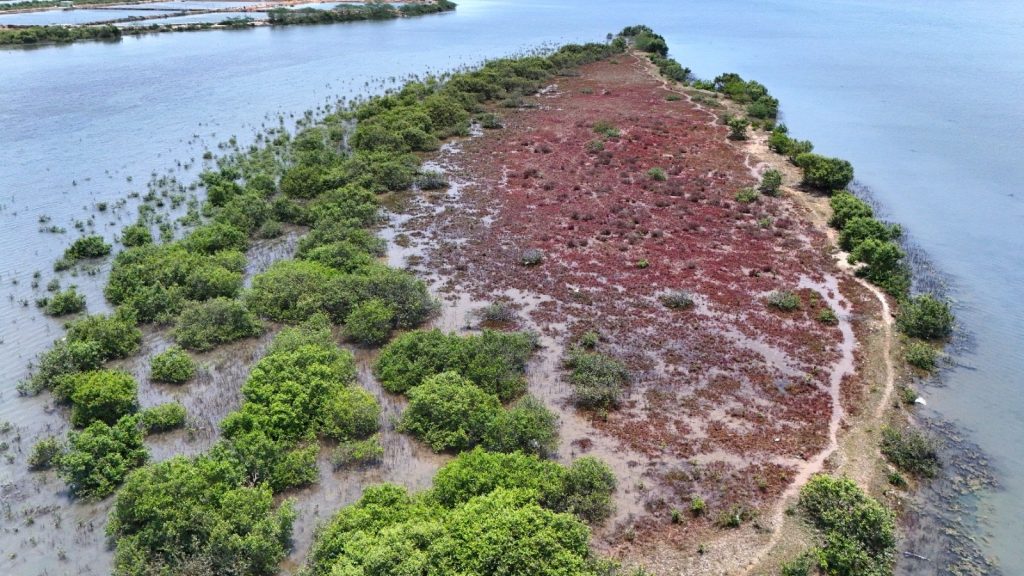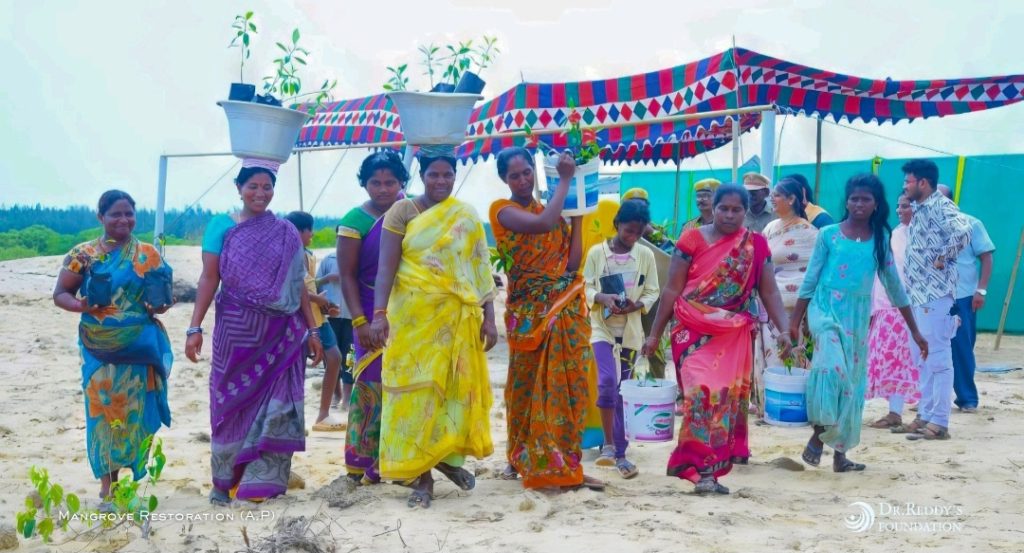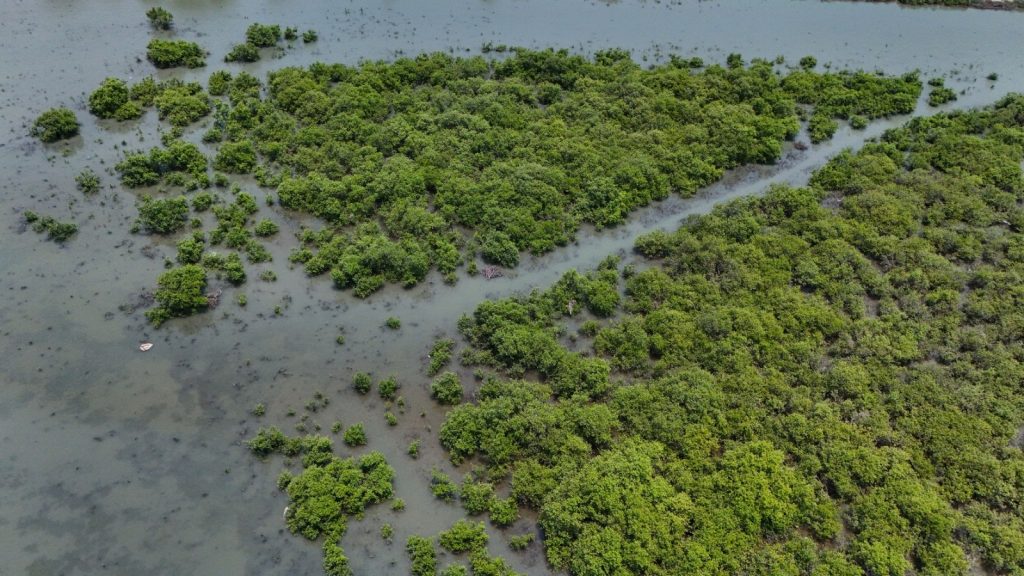One of the ways to mitigate the impact of cyclones and tidal surges in coastal areas is through the restoration of the mangrove ecosystem. A report by Deepanwita Gita Niyogi

Last year, during a visit to the coastal city of Visakhapatnam, Suman S described how his organisation, Dr. Reddy’s Foundation, is trying to focus on the regeneration of the coastal ecosystem.
“Coastal communities are the most vulnerable to climate change impacts. As cyclones pose a grave risk along the Andhra Pradesh coast, there is a need to focus on adaptation and mitigation measures for protection,” he said.
One of the ways to mitigate the impact of cyclones and tidal surges is through the restoration of the mangrove ecosystem. Towards this end, the foundation started work this year under which part of the existing mangrove belt from Visakhapatnam to Srikakulam would be conserved.

“As part of the project involving communities, areas have been demarcated along the coastal belt of Andhra Pradesh. Mangrove restoration work is being carried out using scientific methods. Along with restoration, there will be promotion of mud crabs to enhance the income of the people living along the coastline. Mud crabs are found in mangroves,” Suman added.
A long-term project, it can be showcased as a model to be picked up and replicated by others along the eastern coast of India. On July 26, the International Day for Conservation of Mangrove Ecosystems was observed.
Protecting mangroves
About 40 percent of the world’s mangrove cover is found in two regions: South East Asia and South Asia. India has about three percent of the total mangrove cover in South Asia, according to the Global Mangrove Alliance.
Among the states, West Bengal has 42.45 percent of India’s mangrove cover, followed by 23.66 percent in Gujarat and 12.39 percent in the Andaman and Nicobar Islands. As India is a coastal country reeling under the impact of climate change, mangrove conservation is vital.
In Andhra Pradesh, 404 sq km area is covered by mangroves which fall under the open mangrove and moderately dense mangrove categories, the Global Mangrove Alliance says. Satya Aruna of Dr. Reddy’s Foundation, who holds the position of technical associate, biodiversity, explained that the foundation is laying emphasis on the rejuvenation of the coastal ecosystem under its Action for Climate and Environment Programme.

“The degradation of mangroves is high. That is why the restoration work has been taken up. As the mangroves are under the forest department, the organisation approached government officials to implement the project,” Aruna said. Work has already taken place in Sullurupeta in the Tirupati district of Andhra Pradesh. So far, 200 acres of mangroves have been restored in Tirupati.
To make the project a success, on-site nurseries have been established to collect propagules (plant materials used for propagation) and raise seedlings. This will ensure a 95 percent survival rate.
One of the technical partners in this project is the ICFRE-Coastal Ecosystem Centre based in Visakhapatnam. Scientist Tatiparthi Srinivas said the mission of the institute is to conserve biodiversity across India.
“The institute is at present concentrating on mangroves, as part of which pilot surveys have been carried out. We have identified some patches where restoration activity can be done. In some coastal areas, there is human pressure. In these areas, there is a scope for improvement through revival. Work has been carried out in the Pulicat Lake area. Here, we observed that only specific species of mangroves can survive. Mangroves can restrict damage in the coastal regions. Sometimes, they grow slowly and that is why a scientific approach is needed,” Srinivas added.
S Venkatesh, the divisional forest officer of Srikakulam, said there has been an agreement between the foundation and the forest department.
According to the forest officer, mangroves are important. That is why they need to be protected and restored, especially in sensitive areas. Work in the division will start soon. The foundation will mobilise the local communities for the project.
Mangroves in India
The Forest Survey of India has been assessing the mangrove cover using remote sensing since 1987. There are many important species of mangroves found in the country.
Apart from Andhra Pradesh, Odisha also has a history of getting impacted by frequent cyclones. The state’s Bhitarkanika mangrove forest covers an area of 650 km and is one of the best patches of mangrove forest along the Eastern Indian coast. The Bhitarkanika mangroves offer protection from devastating storm surges.
Spread across India and Bangladesh, the Sundarbans are an archipelago of islands, famous for the world’s largest mangrove forest. However, due to sea-level rise as a result of climate change, mangroves are disappearing.
In the Sundarbans, Kolkata-based non-profit, Nature Environment and Wildlife Society, has worked with communities on restoration of mangroves. Started around 2011, the region witnessed the plantation of 16 million mangroves to strengthen houses and farmlands from flooding, according to the Livelihood Funds which invests in projects across Asia, Africa and Latin America. The other aim was biodiversity protection.
After cyclone Amphan caused large-scale devastation in West Bengal in 2020, Chief Minister Mamata Banerjee launched a mangrove plantation drive in convergence with MGNREGA. Under this, plantations would be carried out in the months of August-October over the next 10 years. Altogether, 2,500 hectares of available land would be covered with 50 million mangroves.
In the Indian Sundarbans, rising sea level is destroying the Sundri trees, the dominant mangrove species, found in the region. This is also impacting the habitat of the tiger.
“There is no freshwater inflow in the Indian Sundarbans. So an increase in salinity is impacting the diversity of vegetation. Many mangroves, which thrive in less salty water, are dying. This in future will impact tiger habitats,” said Jones Justin, deputy field director, Sundarbans Tiger Reserve.













